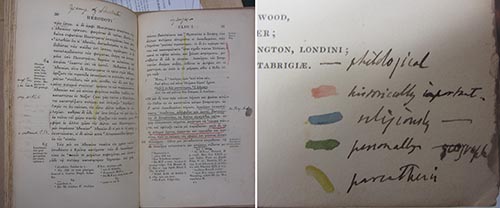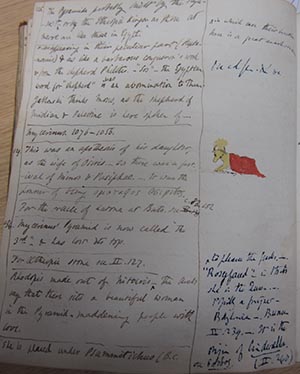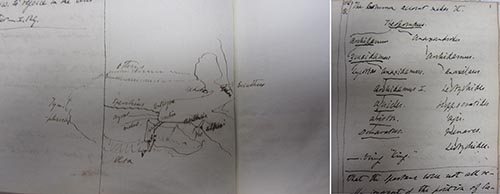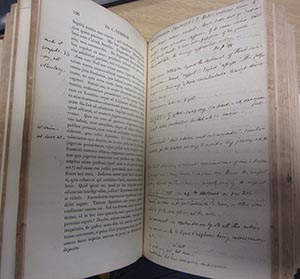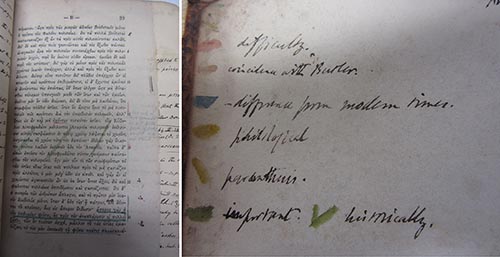Inside a Victorian lecture room
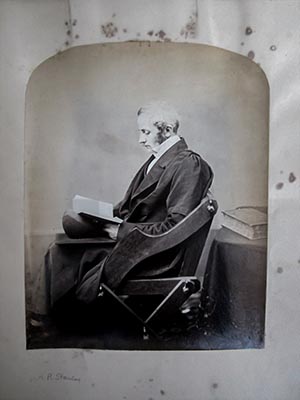
Arthur Stanley – ref. UC:O1/P1/1 fol. 6
For this month’s Treasure we enter the lecture room of one of Univ’s greatest tutors of any period in our history. This is Arthur Stanley (1815-81), who was a Fellow of Univ from 1838-51. Not only did his pupils love and respect him, but he got results, too, with several Univ men of the 1840s getting Firsts in their Finals. During this period he also wrote the first biography of his old teacher, Thomas Arnold, Headmaster of Rugby. Stanley’s biography proved a sensation, and played a central role in establishing Arnold’s position as one of the great educationalists of the early 19th century. He also played an important role in the reform of Oxford in the 1850s.
This photograph of Arthur Stanley from the SCR photograph album, shows him (characteristically) deep in a book.
Stanley had been an undergraduate at Balliol, and ought to have been a Fellow there, but his liberal views on theology made him suspect in that College, and he was encouraged to seek a Fellowship elsewhere. Univ, less censorious than Balliol, wisely seized its moment, and elected him a Fellow instead. In later years Stanley became a leader of the “Broad Church” (i.e. liberal) wing of the Church of England, and a significant figure in the intellectual and religious life of his day. There were many traditionalists who opposed Stanley’s beliefs, and, although his good nature meant that he always retained his opponents’ respect, he was judged not quite orthodox enough ever to be made a bishop. On the other hand, Stanley was a great favourite of Queen Victoria, who was thoroughly in sympathy with his beliefs, and in 1864 she bestowed on him the highest clerical honour in her personal gift when she made him Dean of Westminster Abbey. In the same year Univ elected him an Honorary Fellow.
After Stanley’s death in 1881, he received, as was the custom for a Victorian eminence, an official “life and letters” biography, in this case R. E. Prothero, and G. G. Bradley, The Life and Correspondence of Arthur Penrhyn Stanley (2 vols, London, 1893). George Bradley was a pupil of Stanley’s at Univ, and came back in 1870 as our Master. After a not wholly successful Mastership, he succeeded Stanley as Dean of Westminster in 1881.
Even if Prothero and Bradley are minded, unsurprisingly, to portray Stanley in a positive way, their work is invaluable because they could draw upon memories of Stanley from former pupils who were still alive, as well as quote from letters by Stanley himself which are now lost.
Prothero and Bradley were therefore able to report that, when Stanley started lecturing at Univ, he found it hard work: “The only unpleasant part I find in my lectures is the total absence of any expression of feeling in the faces of my twelve auditors. Not a shadow of joy or sorrow ever passes over their immovable features.” (Prothero and Bradley, i. 309). However, he kept at it, and a little later was able to express his pleasure that “my audience has at last given signs of human feeling by a burst of laughter at a ludicrous story. I was quite alarmed at the effect of my own wit.” (Prothero and Bradley, i. 310).
Stanley certainly did have an effect on his pupils. George Bradley himself tried to explain what it was that made Stanley so charismatic a tutor and lecturer:
It is impossible for me to describe to you—it is difficult for me to analyse to myself—the feeling which he inspired in a circle, small at first, but with every fresh term widening and extending. The fascination, the charm, the spell, were simply irresistible; the face, the voice, the manner; the ready sympathy, the geniality, the freshness, the warmth, the poetry, the refinement, the humour, the mirthfulness and merriment, the fund of knowledge, the inexhaustible store of anecdotes and stories, told so vividly, so dramatically. (Prothero and Bradley, i. 356).
But what was Stanley lecturing and teaching on? In October 1897, some years after Stanley’s death, the minutes of a College meeting recorded a gift to the College of “three books belonging to the late Dean Stanley together with two MS notebooks.” The donor is unnamed, but Stanley’s brother-in-law Charles Vaughan died in that year, and perhaps the books were found among his papers. There are in fact six books in all, and they turn out to be texts which Stanley used when he was a tutor at Univ. Examples of books used by Oxford tutors from the 1840s are extremely rare, and Stanley’s books provide valuable evidence for the way that he taught Univ undergraduates.
Four of the books are classical texts, comprising printed editions of the History of Herodotus, the Politics of Aristotle, and the Verrine Orations of Cicero. The two notebooks consist respectively of detailed notes on Herodotus, and some miscellaneous notes on ancient Greek history.
Stanley was using modern editions. For Herodotus, he used the edition of Thomas Gaisford, published in Oxford in 1830; for the Politics, he turned to August Immanuel Bekker, whose edition appeared in Berlin in 1831; and for the Verrine Orations, he used a version of the edition by Karl Gottlob Zumpt which was published in Oxford in 1831 for the use of Rugby School (and which, almost certainly, Stanley had used when he was a pupil there).
Stanley’s editions of Herodotus, Aristotle and Cicero are all extensively annotated by him. Fig.1 shows a well-annotated opening from Book I of Herodotus.
Another opening (Fig.2, below), also from Herodotus Book I, shows something rather odd. Stanley has covered this page with underlinings in different coloured crayons or washes. And at the start of the book, at the bottom right-hand corner of the title page, is Fig.3 (below):
As one reads through both volumes of Stanley’s Herodotus, so the colour codes keep on recurring, alongside his annotations.
What was Stanley up to? George Bradley stands by, ready to explain. He remembers that, when Stanley began to prepare his lectures, he prepared to lecture on Herodotus. He goes on to say:
“Two or three of us remember that well-marked “Herodotus,” which he freely lent us. It had its special marks in coloured lines to indicate, first, passages noteworthy for the Greek; secondly, passages bearing on Greek history or on the time of Herodotus; thirdly, passages containing truths for all time.” (Prothero and Bradley, i. 332)
We have here Stanley’s “well-marked” copy of Herodotus, and it now becomes clear what Stanley was up to in his annotations. Thus, if we look at pages 50-1 above, we can see that he has decided that it has passages of philological interest (underlined in black), passages that are “historically important” (underlined in red), a passage that looks if it is religiously important (underlined in grey, which might be a faded blue), and passages struck through in green, as being “parenthetical”.
Then there is that notebook on Herodotus. As one reads it, it becomes clear that these are further notes by Stanley on the text. He is always careful to note which passage he is discussing, and so, here is an opening from his notes on Book II, which among other things discusses the strange legend of King Mycerinus of Egypt burying his dead daughter in a wooden cow – hence the unexpectedly charming drawing of a cow (Fig.4).
It is now possible to have a sense of Stanley’s lectures on Herodotus from the 1840s. He was not analysing Herodotus in general, in the way that a Classics lecturer would do today, but rather he was reading over the text, almost line by line, with his pupils, throwing out interesting comments here or there on the text, no doubt hinting as he did so into which category his comments would fall. I would imagine that, as he gave his lectures, he had open both his printed edition and his notes, so that he could move between then.
One must therefore imagine Stanley and his group gradually working their way through the whole of Herodotus, lecture by lecture. In the wrong hands, such a method of lecturing could be excruciating. One hears tales from other Colleges at this date of how a lecturer would once again work through a text, but do pretty well nothing except quote wholesale from existing commentaries. To his great credit, Stanley was determined to be original and compile his own notes.
Stanley did not just use notes. His Herodotus notebook includes maps as well. So at the end of his discussion of Herodotus’s account of the 300 Spartans’ last stand at Thermopylae, he drew in a rough sketch-map of the area (Fig.5, below). Then, in Book VIII, when trying to unravel the genealogies of the kings of Sparta, he drew a little family tree to help him (Fig.6, below).
These two images produce interesting questions. Did Stanley pass this notebook around his students, or did he have a blackboard in his lecture room, onto which he could copy this map and this diagram? It is remarkable in some ways how little we know about these basic aspects of teaching in 19th century Oxford.
Stanley’s copies of Aristotle and Cicero are different from those of his Herodotus, because here he has had both books interleaved, so that he can write his notes on pages facing the printed texts, rather than have to work from two books at once. Stanley’s Cicero has no colour coding, and just consists of marginal notes, of which Fig.7 is fairly typical example.
His copy of the Politics, however, is very different. This opening shows the profusion of colour we experienced with his copy of Herodotus (Fig.8, below). On the inside front cover (Fig.9, below), Stanley wrote down his key to his colour coding – which is quite different from that used in his Herodotus.
Arthur Butler (matr. 1850) remembered well going through the Politics with Stanley:
In treating a difficult and complex book like the “Politics” of Aristotle, he would recommend us carefully to note peculiarities with three varieties of coloured pencils under the following heads: truths for all time, red; truths for the time of Aristotle, blue; and then, with a humourous twinkle of his eye, truths for the schools [sic], black. (Prothero and Bradley, i. 359)
Butler’s colour coding doesn’t match with that which we can see for ourselves in the book, but it is very clear that Stanley’s way of reading a text was something which his pupils remembered affectionately many decades after their time with him.
There are some other little glimpses of Stanley in the lecture rooms. George Bradley remembered attending his lectures on Divinity “in those close-packed chairs that crowded the still damp ground-floor rooms in the then New Buildings as they are still called, on the topmost story of which our lecturer had his rooms.” (Prothero and Bradley, i. 355–6). So popular was Stanley that, at a time when undergraduates were expected only to attend lectures in their Colleges, and nowhere else, Stanley’s pupils successfully persuaded him to allow some of their friends in other Colleges to come to hear him.
Arthur Stanley was clearly an exceptional tutor, who had a great impact on his pupils. We are therefore very fortunate that some evidence, at least, survives to show him in action, not least because such evidence is extremely rare for any Oxford tutor of this period. Perhaps it might have seemed something of a grind to work through Herodotus, Aristotle or Cicero almost line by line, but Stanley at least took care to prepare his texts thoroughly and give his pupils something new.
On the other hand, perhaps these books can only tantalise. At times they feel almost like aids to memory from which Stanley could elaborate or improvise. We need to imagine Stanley’s charm or his jokes breaking through. We need too to remember Bradley’s memories of Stanley’s “fund of knowledge” and “inexhaustible store of anecdotes and stories, told so vividly, so dramatically.” So perhaps we should end this month’s Treasure by imagining Stanley in his lecture room, once he’d copied or passed around that map of Thermopylae, enthralling George Bradley and his friends with his evocation of the battle.
Further Reading:
Robin Darwall-Smith, A History of University College, Oxford (Oxford, 2008), Chapter 15.
R. E. Prothero and G. G. Bradley, The Life and Correspondence of Arthur Penrhyn Stanley (2 vols, London, 1893). This is the “authorised” biography of Stanley, but one which was able to draw upon many first-hand testimonies to his life and character.
John Witheridge, Excellent Dr. Stanley: The life of Dean Stanley of Westminster (London, 2013). This is the best modern biography of Stanley.
Further selected Univ Treasures are detailed below or explore the whole collection on our News and Features Treasures pages.
Published: 20 April 2023


